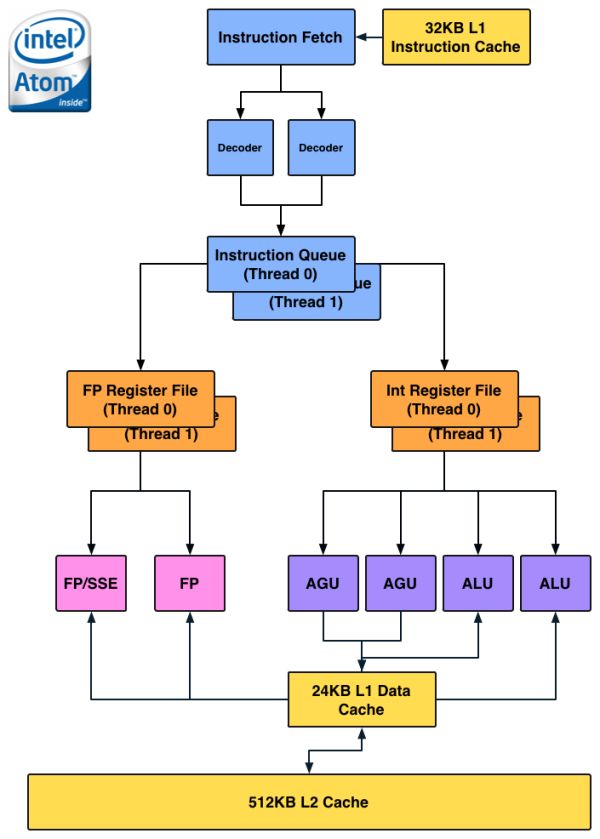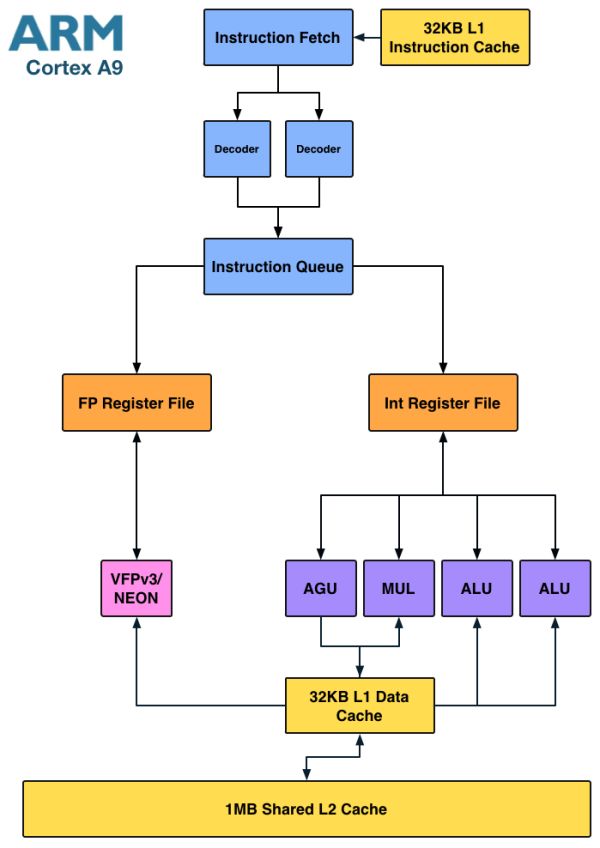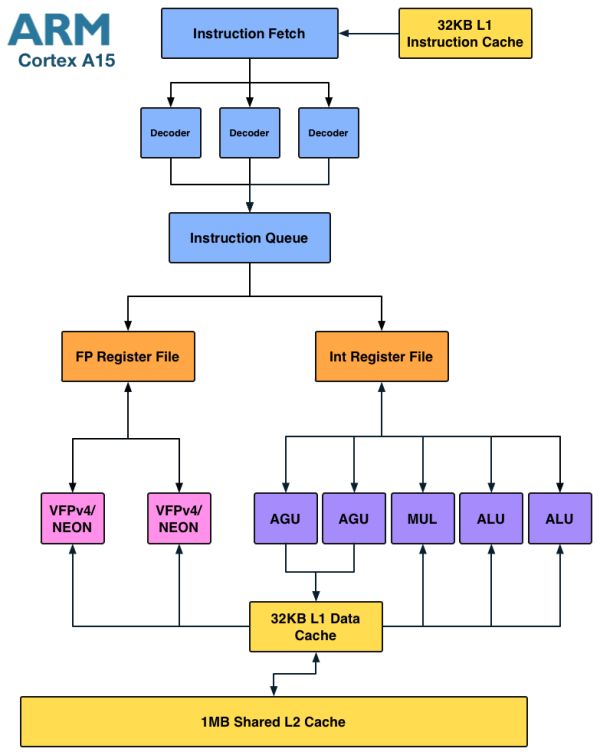Intel's Medfield & Atom Z2460 Arrive for Smartphones: It's Finally Here
by Anand Lal Shimpi on January 10, 2012 8:00 PM ESTThe CPU
Medfield is the platform, Penwell is the SoC and the CPU inside Penwell is codenamed Saltwell. It's honestly not much different than the Bonnell core used in the original Atom, although it does have some tweaks for both power and performance.
Almost five years ago I wrote a piece on the architecture of Intel's Atom. Luckily (for me, not Intel), Atom's architecture hasn't really changed over the years so you can still look back at that article and have a good idea of what is at the core of Medfield/Penwell. Atom is still a dual-issue, in-order architecture with Hyper Threading support. The integer pipeline is sixteen stages long, significantly deeper than the Cortex A9's. The longer pipeline was introduced to help reduce Atom's power consumption by lengthening some of the decode stages and increasing cache latency to avoid burning through the core's power budget. Atom's architects, similar to those who worked on Nehalem, had the same 2:1 mandate: every new feature added to the processor's design had to deliver at least a 2% increase in performance for every 1% increase in power consumption.
Atom is a very narrow core as the diagram below will show:
There are no dedicated integer multiply or divide units, that's all shared with the FP hardware. Intel duplicated some resources (e.g. register files, queues) to enable Hyper Threading support, but stopped short of increasing execution hardware to drive up efficiency. The tradeoff seems to have worked because Intel is able to deliver performance better than a dual-core Cortex A9 from a single HT enabled core. Intel also lucks out because while Android is very well threaded, not all tasks will continually peg both cores in a dual-core A9 machine. At higher clock speeds (1.5GHz+) and with heavy multi-threaded workloads, it's possible that a dual-core Cortex A9 could outperform (or at least equal) Medfield but I don't believe that's a realistic scenario.
Architecturally the Cortex A9 doesn't look very different from Atom:
Here we see a dedicated integer multiply unit (shared with one of the ALU ports) but only a single port for FP/NEON. It's clear that the difference between Atom and the Cortex A9 isn't as obvious at the high level. Instead it's the lower level architectural decisions that gives Intel a performance advantage.
Where Intel is in trouble is if you look at the Cortex A15:
The A15 is a far more modern design, also out of order but much wider than A9. I fully expect that something A15-class can outperform Medfield, especially if the former is in a dual-core configuration. Krait falls under the A15-class umbrella so I believe Medfield has the potential to lose its CPU performance advantage within a couple of quarters.
Enhancements in Saltwell
Although the CPU core is mated to a 512KB L2 cache, there's a separate 256KB low power SRAM that runs on its own voltage plane. This ULP SRAM holds CPU state and data from the L2 cache when the CPU is power gated in the deepest sleep state. The reasoning for the separate voltage plane is simple. Intel's architects found that the minimum voltage for the core was limited by Vmin for the ULP SRAM. By putting the two on separate voltage planes it allowed Intel to bring the CPU core down to a lower minimum power state as Vmin for the L2 is higher than it is for the CPU core itself. The downside to multiple power islands is an increase in die area. Since Medfield is built on Intel's 32nm LP process while the company transitions to 22nm, spending a little more on die area to build more power efficient SoCs isn't such a big deal. Furthermore, Intel is used to building much larger chips, making Medfield's size a relative nonissue for the company.
The die size is actually very telling as it's a larger SoC than a Tegra 2 with two Cortex A9s despite only featuring a single core. Granted the rest of the blocks around the core are different, but it goes to show you that the CPU core itself (or number of cores) isn't the only determination of the die size of an SoC.
The performance tweaks come from the usual learnings that take place over the course of any architecture's lifespan. Some instruction scheduling restrictions have been lifted, memory copy performance is up, branch predictor size increased and some microcode flows run faster on Saltwell now.
Clock Speeds & Turbo
Medfield's CPU core supports several different operating frequencies and power modes. At the lowest level is its C6 state. Here the core and L2 cache are both power gated with their state is saved off in a lower power on-die SRAM. Total power consumption in C6 of the processor island is effectively zero. This isn't anything new, Intel has implemented similar technologies in desktops since 2008 (Nehalem) and notebooks since 2010 (Arrandale).
When the CPU is actually awake and doing something however it has a range of available frequencies: 100MHz all the way up to 1.6GHz in 100MHz increments.
The 1.6GHz state is a burst state and shouldn't be sustained for long periods of time, similar to how Turbo Boost works on Sandy Bridge desktop/notebook CPUs. The default maximum clock speed is 1.3GHz, although just as is the case with Turbo enabled desktop chips, you can expect to see frequencies greater than 1.3GHz on a fairly regular basis.
Power consumption along the curve is all very reasonable:
| Medfield CPU Frequency vs. Power | ||||||
| 100MHz | 600MHz | 1.3GHz | 1.6GHz | |||
| SoC Power Consumption | ~50mW | ~175mW | ~500mW | ~750mW | ||
Since most ARM based SoCs draw somewhere below 1W under full load, these numbers seem to put Medfield in line with its ARM competitors - at least on the CPU side.
It's important to pay attention to the fact that we're dealing with similar clock frequencies to what other Cortex A9 vendors are currently shipping. Any performance advantages will either be due to Medfield boosting up to 1.6GHz for short periods of time, inherently higher IPC and/or a superior cache/memory interface.













164 Comments
View All Comments
reenie49 - Wednesday, January 11, 2012 - link
The numbers from Medfield seem competitive with current Arm A9 SOC's , but these are Intel numbers and until the phones are out then we just don t really know , Intel has promised before . In a few months A15 chips at 28 nm will be out and they "should" post higher performance and/or lower power than A9 so will be infront again . But performance is only half the battle , what about cost ? Is Medfield as cheap as Arm ? Intel likes big profit margins and cripples the low end to protect the high end , It is used to charging 60 dollars plus per chip not sub 20 dollars, does Intel really want to be in an arms race with samsung etc ? Will phone manufactures be happy to be tied to one chip producer and pay more for the privilege ? With Arm , they have a choice of 3 or 4 different SOC's or can build there own . So as it has been said before, Intel will have to be alot better to be a reason to ditch Arm . Think it will be another 2 to 3 years before we see a winner in top end smartphones and tablets . I think Arm will still dominate the low end phones with A7 etc, can t see Intel wanting to be in the sub 10 dollar chip market . Has Arm announced its successor to A15 ?ThomasS31 - Wednesday, January 11, 2012 - link
The real deal here is x86 compatibility with Windows 8 coming you can run all you apps from your phones, tablets or high and PCs... it will all work on the intel ecosystem. Evey your old apps.That is a hugh deal vs the ARM ecosystem. You will have Windows 8 ofc, but some old apps simply won't work.
And on 22nm very soon, this will be a killer design in my opinion.
french toast - Wednesday, January 11, 2012 - link
Thankyou for posting this insight into Medfield, you always give the best in depth analysis on the internet, usually without all the biased, speculatory fud.However i have noticed that you have a slight bias towards Intel, nothing major but you seem to give them more benefit of the doubt than they can prove.
You stated thus;
'' Even today it appears to deliver better CPU performance than anything on the market, despite only having a single core''
Nonsense.
This in no way proves that Medfield is a faster chip than say Exynos 4210 from last year.
In fact as you state that Atom is the same architecture, i would say evidence says that even tegra 2 is faster according to these benchmarks ;
http://www.phoronix.com/scan.php?page=article&...
The 2 Intel sourced benchmarks that you sourced do not give the complete picture to go drawing such conclusions, either about the platform or the architecture.
The cortex A9 is at minimum the same performance clock for clock according to more complete benchmarks i linked above, Multi threading which does have uses in Android and even webrowsing/games will be superior on 2 A9s, also if you put both on the same process the A9s will be substantially smaller and consume substantially less power.
Other web site that i have read said that the Medfield reference phone was slightly choppy/laggy when scrolling the home sreen, which they noted doesn't happen on Exynos.
Which is clocked lower and will be 18months older by the time Medfiled releases.
Some else pointed out about which gingerbread update is it running? ove at xda forum they report ICS gains in performance on 2.3.7 for example....
Whilst it is interesting to put up this Intel promotion, it does not conclude that this would have dominated android last year at all, it seems at first glance that it would have been COMPETITIVE last year. there is no proof that an Atom is even on par with A9/same clock speed let alone Krait.
After all the excellant articles i have read on this site, i expected a little better too be honest.
BSMonitor - Wednesday, January 11, 2012 - link
Are you completely mental?? You are comparing miniITX platforms running Ubuntu to SoC's running Android. Your benchmarks are completely meaningless.french toast - Wednesday, January 11, 2012 - link
No there not, they are the only comparable benchmarks that put both architectures through their paces, if you level the clocks the A9s smoke the Atoms...Anand says him self that the Achitecture remains the same.There certainly more comparable than this Intel marketing blitz.
The power point slides above say that Medfield will have substantially more gpu performance than a iphone 4s,samsung galaxy s2..as we know its a sgx540@400 i highly doubt it somehow.
My point is the tests are provided by intel, or run on limited benchmarks that dont test cpu LOAD scenarios, that are not multithreaded, not standardised software, and the atoms are running at a higher clock rate.
No real world power consumption tests were done, yet bizarly, Anand draws the conclusion that it is the superior architecture and would have 'dominated' android last year... i dont see it that way myself.
guilmon19 - Wednesday, January 11, 2012 - link
why is it meaningless? in the intel benchmark they were comparing android 4.0 to 2.3, and from what iv'e read they're very different. While all the miniITX platforms in the other benchmark use a consistent base for all of the hardware by using the same OS. Plus a miniITX is pretty similar to a SoC. The only difference is that SoC are usually smaller and more integrated, but other then that they use very similar hardwarefrench toast - Thursday, January 12, 2012 - link
I agree, the medfields were running on android 2.3.7 which is heavilly optimised compared to the software that some of the others were running on, that alone makes it void.One of the websites ran a quadrant score on the reference platform and got an impressive 3791 how ever the galaxy note, which runs a 1.4ghz exynos and has a core idle. gets 4300+..so that puts it into perspective.
Anand has got a very good reputation for cutting out all the crap and just looking at things in a very objective/logical/technical way, with out jumping the gun and making false assumptions, i hope this continues and we dont see this Intel spin anymore.
halcyon - Wednesday, January 11, 2012 - link
Why don't you benchmark it against Qualcomm S4 A15 Quad?Or the next gen Samsung A15 quads?
Both of those will ship *BEFORE* Medfield devices actually ship.
And they will have lower LTE (not just 3G) idle, highe GPU speeds, and equal/higher perf clock-for-clock.
It looks like Intel *almost* made it this year, but not quite.
Oh well, perhaps the next revision...
BSMonitor - Wednesday, January 11, 2012 - link
Because there is no A15 Quad fully functioning reference phone. Weird.Lucian Armasu - Wednesday, January 11, 2012 - link
Does Atom stand a chance? You say it will be out by the end of the year. We should have at least 2, if not 3 chips based on Cortex A15 by then, one by Samsung at 2 Ghz each core, one by TI (OMAP 5 at 2.5 Ghz), and possibly another one by Samsung that also uses big.Little together with Cortex A7, for even lower power consumption.How will this single core Atom processor be competitive with one of those dual-core processors?
And that's without even counting the dual-core/quad-core Krait chips, which if I'm not mistaken, you've already said they should be more powerful than Atom.